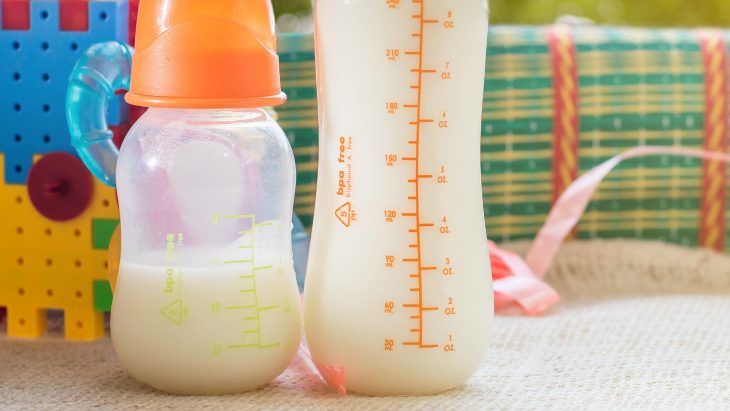If you’ve ever noticed frothy bubbles in your breast milk, it may have left you wondering what was up. Though foamy breast milk or as they call it fizzy breast milk isn’t ideal, it doesn’t necessarily mean something is amiss. Nevertheless, it can be helpful to know what causes foamy breast milk and whether or not it is safe for your baby to consume. To learn more about this common occurrence, be sure to stick around…we’re getting ready to dive into this topic right now!
Why Does Breast Milk Get Foamy?
Why Does My Breast Milk Look Foamy?
Breast milk can get foamy for a multitude of reasons.
Oftentimes, women think that their foamy breast milk is a signal that it has gone bad. In all actuality, the milk may be fine.
However, it may be foamy on top for reasons unrelated to being spoiled.
Why Is My Breast Milk Foamy?
Breast milk that looks foamy may be startling at first, but knowing what causes foamy breast milk can help alleviate your fears. One of the causes could simply be pumped breast milk, meaning that you were pumping it too fast. Sometimes frozen breast milk or refrigerated breast milk can get air bubbles if you warm it up too fast.
Breast milk most commonly looks foamy because of the following reasons:
- The Force Behind The Milk Let Down When Pumping
- Faulty Pump or Pump Parts
- The Amount of Lipase in Humans’ Milk

Why Is My Breast Milk Foamy When Pumping?
Foamy Breast Milk When Pumping
Breast milk can be foamy when pumping for several reasons.
One of the most common reasons is high lipase content. Lipase is a fat-digesting enzyme in the milk that, when present in high amounts, can cause breast milk to look foamy. High lipase in breast milk may also cause your milk to taste and smell like soap.
Related Read: How To Pump More Milk At Work
Another reason for foamy breast milk when pumping is a forceful letdown. If you have a forceful letdown while pumping, it may be that the force of the milk hitting the bottle is making the milk bubbly and foamy. To fix the situation, you can try hand expressing a little milk before actually pumping, as this may lessen pressure when pumping.
Lastly, and very commonly, foamy breast milk may be a sign of a faulty breast pump or pump parts. Sometimes when certain parts or connections get loose, the result is bubbly and foamy breast milk. To fix this problem, you may consider disassembling your pumping unit and reassembling it to make sure all parts are correctly tightened. If you continue to experience the issue and are certain that the pump is to blame, you may need to purchase a new pump.
Foamy Breast Milk in Fridge
Foamy Bottled Breast Milk
If you notice that your milk has gotten foamy in a bottle in the fridge, don’t worry. It was likely foamy before you placed it there.
As long as you know that the breast milk is fresh, there shouldn’t be any reason to assume that your breast milk is spoiled.
Still, bubbly breast milk may cause some issues for your baby, so be sure to use the “scissor” method to get those bubbles out. More on that later!
Foamy Breast Milk Haakaa
Breast milk can be foamy in a Haakaa for the same reasons it can be foamy with a traditional pump. Usually, high lipase or a forceful letdown is to blame when using a Haakaa pump.
Lipase Breast Milk
As previously mentioned, excess lipase can be the cause of bubbles in breast milk. There isn’t much you can do about lipase in your milk except for scalding the milk.
To do so, heat the milk to 180 degrees Fahrenheit before allowing the milk to cool and then refrigerating or freezing it. The taste and smell of lipase should be gone after following these methods.
Soap Bubbles in the Milk
Though this usually isn’t the cause for foamy or soapy-tasting and smelling breast milk, it is possible that you didn’t wash all of the soap out of the bottle before putting your fresh breast milk in it. This is likely only the case if you know you’ve washed the bottle by hand and used an excessive amount of dish soap and neglected to rinse it thoroughly.
If you were in a rush and suspect this may have happened, avoid feeding your baby the milk and opt to give your baby a fresh new bottle.
Is Foamy Breast Milk Safe?
Foamy breast milk may not do serious harm to your baby. But it may cause them a bit of discomfort.
Common side effects of your baby having consumed foamy milk are excess gas, fussiness, and spitting up.

Foamy Breast Milk Poop
Contrary to popular belief, foamy poop is not necessarily an indicator of having ingested foamy breast milk. Rather, foamy poop may be a signal that your baby is getting too much foremilk instead of hindmilk, as foremilk is a lot more watery than hindmilk and thus can produce foamy stools when consumed in excess.
How to Get Rid of Bubbles in Breast Milk
Getting the bubbles out of breast milk can be done using the “Scissor” method.
To do this, put all of your breast milk in a freezer storage bag and make sure to only partially seal the bag on one side. Then, using your fingers like scissors, squeeze the air in the bag up to the top of the bag. Keep doing this until the air in the bag has disappeared.
Is It Normal For Milk to Be Foamy? Yes and No!
While not everyone experiences foamy breast milk, it is a common occurrence. Still, you will want to remediate the issue of foamy milk by getting down to the root cause of it because serving your baby milk with a lot of bubbles in it may upset your baby’s stomach.
We hope this helps!
For more info on breast milk, check out these posts:

Leave a Reply